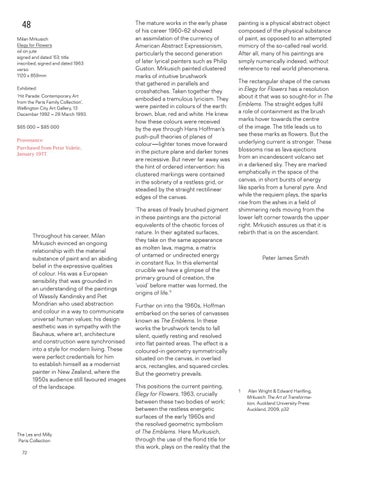48 Milan Mrkusich Elegy for Flowers oil on jute signed and dated ’63; title inscribed, signed and dated 1963 verso 1120 x 859mm Exhibited: ‘Hit Parade: Contemporary Art from the Paris Family Collection’, Wellington City Art Gallery, 13 December 1992 – 28 March 1993. $65 000 – $85 000 Provenance: Purchased from Petar Vuletic, January 1977.
Throughout his career, Milan Mrkusich evinced an ongoing relationship with the material substance of paint and an abiding belief in the expressive qualities of colour. His was a European sensibility that was grounded in an understanding of the paintings of Wassily Kandinsky and Piet Mondrian who used abstraction and colour in a way to communicate universal human values; his design aesthetic was in sympathy with the Bauhaus, where art, architecture and construction were synchronised into a style for modern living. These were perfect credentials for him to establish himself as a modernist painter in New Zealand, where the 1950s audience still favoured images of the landscape.
The Les and Milly Paris Collection 72
The mature works in the early phase of his career 1960-62 showed an assimilation of the currency of American Abstract Expressionism, particularly the second generation of later lyrical painters such as Philip Guston. Mrkusich painted clustered marks of intuitive brushwork that gathered in parallels and crosshatches. Taken together they embodied a tremulous lyricism. They were painted in colours of the earth: brown, blue, red and white. He knew how these colours were received by the eye through Hans Hoffman’s push-pull theories of planes of colour—lighter tones move forward in the picture plane and darker tones are recessive. But never far away was the hint of ordered intervention: his clustered markings were contained in the sobriety of a restless grid, or steadied by the straight rectilinear edges of the canvas. ‘The areas of freely brushed pigment in these paintings are the pictorial equivalents of the chaotic forces of nature. In their agitated surfaces, they take on the same appearance as molten lava, magma, a matrix of untamed or undirected energy in constant flux. In this elemental crucible we have a glimpse of the primary ground of creation, the ‘void’ before matter was formed, the origins of life.’1
painting is a physical abstract object composed of the physical substance of paint, as opposed to an attempted mimicry of the so-called real world. After all, many of his paintings are simply numerically indexed, without reference to real world phenomena. The rectangular shape of the canvas in Elegy for Flowers has a resolution about it that was so sought-for in The Emblems. The straight edges fulfil a role of containment as the brush marks hover towards the centre of the image. The title leads us to see these marks as flowers. But the underlying current is stronger. These blossoms rise as lava ejections from an incandescent volcano set in a darkened sky. They are marked emphatically in the space of the canvas, in short bursts of energy like sparks from a funeral pyre. And while the requiem plays, the sparks rise from the ashes in a field of shimmering reds moving from the lower left corner towards the upper right. Mrkusich assures us that it is rebirth that is on the ascendant.
Peter James Smith
Further on into the 1960s, Hoffman embarked on the series of canvasses known as The Emblems. In these works the brushwork tends to fall silent, quietly resting and resolved into flat painted areas. The effect is a coloured-in geometry symmetrically situated on the canvas, in overlaid arcs, rectangles, and squared circles. But the geometry prevails. This positions the current painting, Elegy for Flowers, 1963, crucially between these two bodies of work; between the restless energetic surfaces of the early 1960s and the resolved geometric symbolism of The Emblems. Here Murkusich, through the use of the florid title for this work, plays on the reality that the
1
Alan Wright & Edward Hanfling, Mrkusich: The Art of Transformation, Auckland University Press: Auckland, 2009, p32
